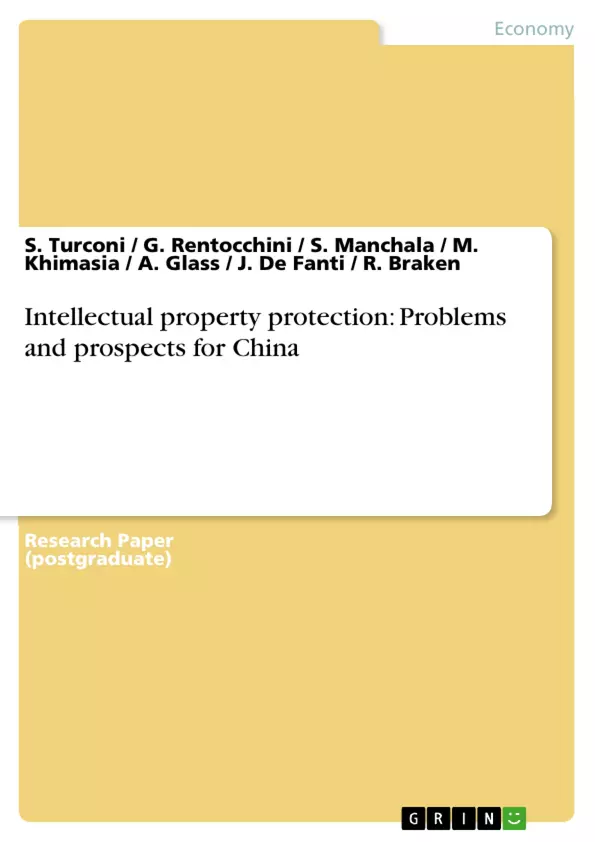China position as the world leader in economic growth has been accompanied by the disregard of existing intellectual property rights (IPR) observed by most of the developed western countries. In this paper, we will discuss the value of strong IPR enforcement to mature economies vs. developing nations and where China lies on the economic maturity scale. While the legal frameworks are improving with China’s entry into the WTO, effective enforcement is far from satisfactory. The challenges focus around protectionism, corruption and cultural issues amongst others. The evidence shows an economy in transition that currently has little domestic motivation to enforce IPR rigorously.
China faces significant international pressure to reform its practices surrounding IPR. The differing perspectives on IPR reflect the relative maturity of a nation’s economy. Developed countries rely heavily upon individuals, educational systems and commercial enterprises to continuously innovate. It is therefore natural for these nations to seek protection, preserving their competitive advantage and maximizing the value they can extract from the resulting innovation. China is a vast country trying to balance the prosperity and relative wealth of its 500 million coastal dwellers against the poverty of the 800 million living in the interior. This represents a great challenge for the government in balancing their long-term objective of transforming the economy vs. the short-term priorities of social equality, employment and the avoidance of civil un-rest.
The rate of reform exhibited on IPR issues will be directly tied to the speed of emergence of Chinese firms capable of patentable innovation. A new generation of technology companies, entrepreneurs and designers will increasingly demand protection for their own IPR. We explore IPR issues in China across two broad industry groupings: “Research oriented” and “Design oriented”. Research oriented industries require high level of skills and tend to be capital intensive. Design oriented industries while requiring high skills, are not capital intensive and reveal rampant counterfeiting & piracy. Foreign firms try to protect their goods through security, quality & bundling service components with products, making them hard to replicate. Success is varied and in these sectors it appears as if counterfeiting and piracy is a price for market access and a low cost manufacturing base.
Inhaltsverzeichnis (Table of Contents)
- Executive Summary
- 1. The Case for IPR Protection
- 2. IPR in China - A Macro Perspective
- The Two Branches of Intellectual Property
- TRIPS Agreement - An Overview
- 3. Towards A Stronger IPR Regime In China
- The IP violators' dictionary
- Worst Case Scenario: Magnetic Secrets
- 4. Industry View - Technology
- Research collaborations by multinationals in China
- 5. Industry View - Pharmaceuticals
- Microsoft and Legal Recourse; the case for "Guanxi"
- 6. Industry View - Software And Media
- Green Shoots: the Emergence of Chinese Generated IP - Dali Industries
- 7. Industry View - Luxury Goods
- Bags of Trouble: The Global Appeal of Super Fake Products
- 8. Conclusion: Living with Piracy
Zielsetzung und Themenschwerpunkte (Objectives and Key Themes)
This paper explores the significance of strong intellectual property rights (IPR) enforcement in both mature and developing economies, with a specific focus on China. The paper analyzes the current state of IPR in China, examining the challenges and opportunities for businesses operating in this dynamic market.
- The role of IPR in economic development
- The current state of IPR protection in China
- The challenges and opportunities of doing business in China's IPR environment
- The impact of IPR issues on different industry sectors in China
- The prospects for improvement in China's IPR regime
Zusammenfassung der Kapitel (Chapter Summaries)
The report begins by discussing the importance of strong IPR protection for fostering innovation and technology growth, while also acknowledging the argument that such protection may not always be beneficial for developing economies. It then provides an overview of the current state of IPR in China, examining the complexities and contradictions of the country's approach to intellectual property. The report continues by exploring the challenges and opportunities of doing business in China's IPR environment. This includes a detailed analysis of the industry sectors, focusing on technology, pharmaceuticals, software and media, and luxury goods. The paper highlights the unique characteristics of each sector in relation to intellectual property rights, and examines the impact of piracy and counterfeiting on these industries.
Schlüsselwörter (Keywords)
This report delves into the crucial topic of intellectual property protection in China, examining its impact on the country's economic development and global trade. The key terms and concepts discussed include: intellectual property rights (IPR), intellectual property enforcement, innovation, technology transfer, counterfeiting, piracy, trade barriers, economic growth, emerging markets, China's legal system, and business strategies in China.
- Citation du texte
- S. Turconi (Auteur), G. Rentocchini (Auteur), S. Manchala (Auteur), M. Khimasia (Auteur), A. Glass (Auteur), J. De Fanti (Auteur), R. Braken (Auteur), 2007, Intellectual property protection: Problems and prospects for China, Munich, GRIN Verlag, https://www.grin.com/document/144405



